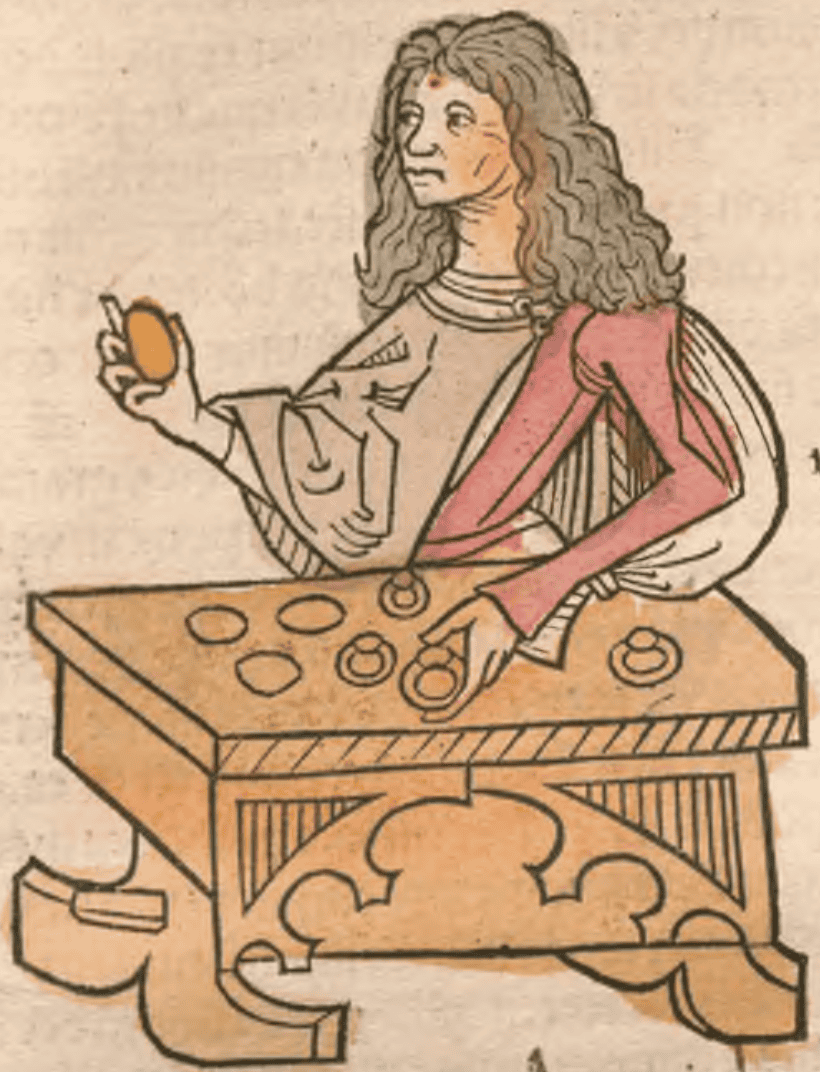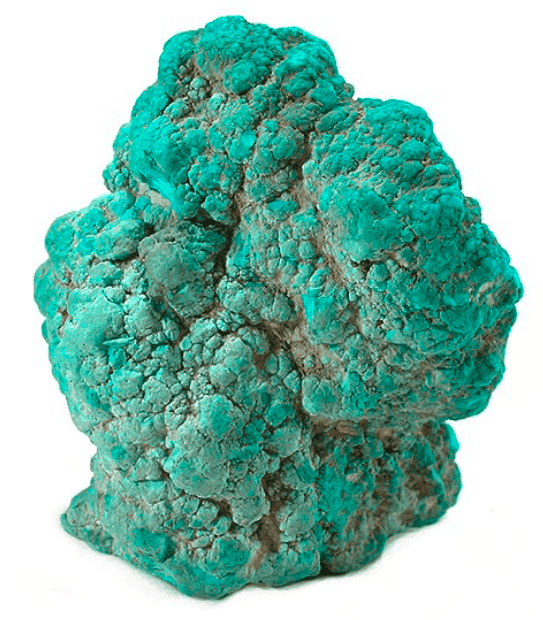Turquoise
Turkey StoneTurchois (Latin)
Gyu གཡུ་ (Tibet)
Lu Song Shi (TCM)
Rajvart, Turkhaja, Viraja, Pirojaka (Ayurveda)
Firoza (Unani)
 Turchois
TurchoisHortus sanitatis, 1491
 Turquoise (Arizona)
Turquoise (Arizona)(Photo by Rob Lavinsky, iRocks.com)
Minerological name:
Turquoise CuAl6(PO4)4(OH)8·4H2O
Hydrated Copper and Aluminium Phosphate (CuO 9.78%; Al2O3 37.6%; P2O5 34.9%; H2O 17.7%).
Copper is responsible for its Green color, although Iron is said to contribute also.
Dark blue Turquoise has higher Copper content, Green-blue Turquoise has higher Ferrous content.
Parts used:
Finely levigated stone
Salmon said ‘it is of a dark sky-colored, green, or greenish-blue and said they are either Oriental or Occidental:
- Oriental: from Persia and India (via Turkey, hence the name)
- Occidental: from Germany, Spain, Silesia, Bohemia.
Some said the best was the color of Verdigris.
In Tibet, ‘Old’ Turquoise is preferred in medicine. That is Turquoise which has been mined in the past as opposed to recently mined Tuquoise. The old stone is a deeper green color.
Temperature & Taste:
Cool, dry. Sweet
Properties:
Crystal system: Triclinic
Color: sky-blue, green-blue
Streak: Bluish white
Cleavage: Good to perfect; usually not applicable
Fracture: Conchoidal
Luster: Waxy to subvitreous
Transparency: no
Hardness: 6
Specific Gravity: 2.6–2.8
Luminesces greenish-yellow or light blue.
Slightly soluble in HCl.
Uses:
1. Benefits the Heart and Brain, Calms the Spirit: (Ayurveda, Tibet, West)
-‘revives the Spirits, refreshes the Heart’ (Mylius)
-Heart disease, Palpitations
-Melancholy, Mental disease, diseases caused by Evil Spirits (Ayurveda, Tibet, West)
2. Clears Heat and Poison, Benefits the Liver: (Ayurveda, Tibet, West)
-chronic Liver disease, Liver damage, Hepatitis, Cirrhosis
-Liver hardness, Liver Tumors
-said to regenerate the Liver (Tibetan Medicine)
-Jaundice (West)
-Fever and Poison associated with the Liver
3. Strengthens the Eyesight: (West, Ayurveda)
-strengthens the sight, poor or failing sight
-like Emerald, the beautiful color was said to please the Eyes
-Egyptians reportedly applied Turquoise for Cataracts
4. Other:
-promotes digestion, used for Duodenal Ulcers (Ayurveda)
-Heat of the Lungs (Tibetan Medicine)
-Urinary stones (Unani)
Dose:
Prepared Powder: 125–500mg (Ayurveda), up to 1 gram (West)
Comment:
1. It was long believed to grow pale and lose its color if the wearer grew sick or had a fever. Conversely, when the owner became healthy again, the stone would again return to its fine color. Salmon (Seplasium) relays the story witnessed by another, that upon the death of the wearer, a beautiful Turquoise became dull and colorless, and was sold off cheaply. After being sold, it returned to its fine color again. This is identical to what the Tibetans say regarding Turquoise color and the health of the wearer.
2. Some claimed that during the day, the color should be like a fine sky blue, but at night time, it became greenish colored.
3. In Tibet, Turquoise is regarded as a superior gem, second only to diamond.
4. The lost color of a Turquoise stone was said to be revived by being rubbed with Oil of Vitriol.
Preparation:
1. Levigated Turquoise:
It can be levigated (finely powdered) with Rose (or other) water until fine enough not to be felt between the fingers when rubbed.
2. Prepared Turquoise (Tibetan):
Turquoise is boiled with Chebulic Myrobalan, Dryopteris root (Re ral) and Saltpeter for 4 hours. The water and herbs are disgarded and the Turquoise is washed well. After processing the color of the Turquoise is much lighter.
3. Bhasma of Turquoise:
It can also be prepared as Bhasma in the same way as Lapis Lazuli.
Substitute:
Turquoise has been accepted as a substitute for Silver in Unani Medicine.
Main Combinations:
1. Tonify the Heart and Brain, balance Wind/Bile and Phlegm, and strengthen the whole body, It clears Ama (toxin from undigested food), resists Poisons in general, and is especially good for those doing lots of mental work. triturated Turquoise with Triturated Topaz, Aquamarine and Coral, Bhasma of Gold, Silver, Zinc and Mica, with Bdellium (Guggulu), Tinospora and Shilajit, in a base of Ghee (as in Navratnakalpa Amrit of Ayurveda)
2. Liver disease with weakness, lethargy, heaviness, poor appetite and gradual wasting:
i. Turquoise with Chebula, Sandalwood, Bile, Musk, Saffron, Shilajit (Tibetan Medicine)
ii. Turquoise with Saffron, Herpetospermum, Meconopsis, Dracocephalum, Corydalis impatiens, Bile, Shilajit
3. Severe chronic Liver diseases, Cirrhosis, Liver Tumors, Turquoise with Triphala, Costus, Aloeswood, Sandalwood, Nux Vomica purified, Pearl, Red Coral, Shilajit, Bezoar, Clove, Tabasheer, Saffron (as in Turquoise 25 of Tibetan Medicine)
4. Chronic Fever, Poisoning, Turquoise with Chebula, Shilajit, Costus, Picrorhiza, Gentian, Swertia, Sandalwood, Tabasheer, Saffron, Clove, Pearl, Musk. In severe cases, Pearl, Rhino horn and Bezoar are added. (as in Dug sman man sbyor chen mo of Tibetan Medicine)
Major Formulas:
Navratnakalpa Amrit (Ayurveda)
Dug sman man sbyor chen mo (Tibetan)
Precious and Great Multi-Jewel Compound Pill (Rin chen mang sbyor chen mo) (Tibetan)
Precious Wish Fulfilling Jewel (Rin chen ratna bsam ‘phel) (Tibetan)
Turquoise 25 (Rin chen gyu rnying nyer lnga)
Cautions:
None noted.
Main Preparations used:
Levigated Powder (Pishti), Bhasma
1. Cupric Oxide (which accounts for almost 10% of the weight of Turquoise) has been used medicinally for Worms (Tape), and as a Resolvent; used (mostly externally in ointments) for chronic indurated glands, varicose ulcers, arthritis, myalgia etc. (Merc Index) It was used in doses of 50-100mg., meaning that a dose of 500mg-1 gram of Turquoise would supply a medicinal dose of Cupric Oxide. Its use as a resolvent may be related to its reported effects against Liver Tumours in Tibetan Medicine. The Bhasma of Copper (similar to the Oxide) has likewise been established as a Hepatoprotective, and has long been used for Chronic Liver disease in Ayurveda.
